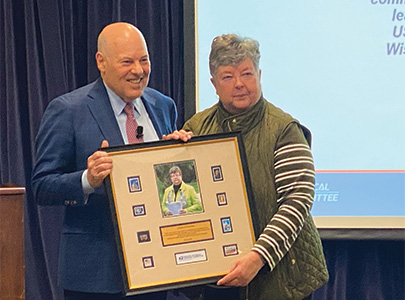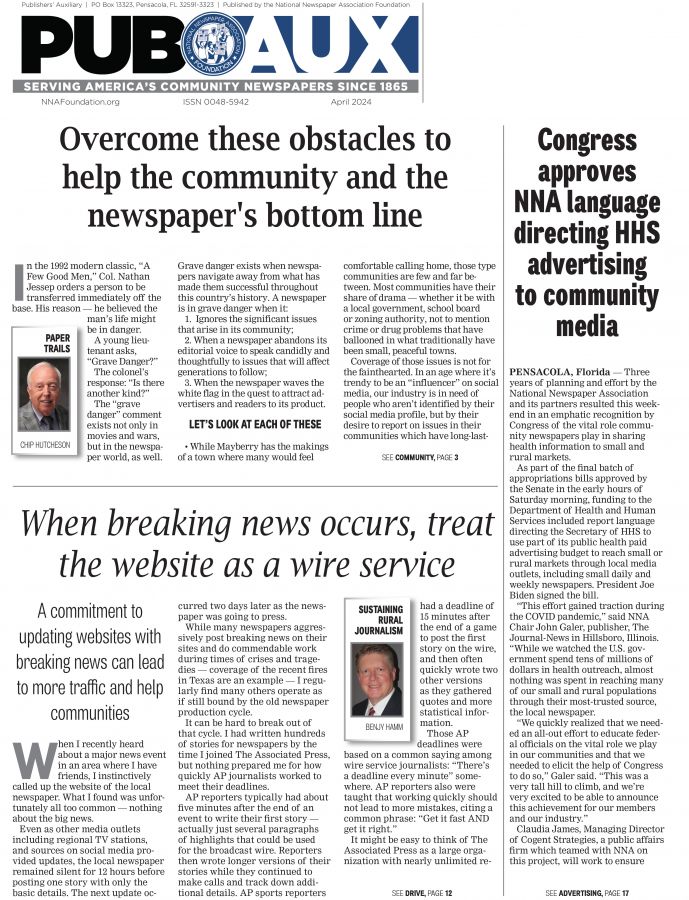‘The blue sky turned black— ash and soot rained down’
Nov 2, 2015
The images of the giant Washington fire on the Omak-Okanogan Chronicle’s Facebook page and Twitter feed are dramatic.
Washington weekly marshals resources to cover fires, save lives and win awards
By Teri Saylor
Special to Publishers’ Auxiliary
The images of the giant Washington fire on the Omak-Okanogan Chronicle’s Facebook page and Twitter feed are dramatic.
There are houses in silhouette against an orange and black sky and skeletons of other homes engulfed in flames that seem to feast on the bits of wood, like flesh, left clinging to the bones.
Helicopters hover over new hotspots dangling buckets of quenching water on long cables.
A bright orange glow illuminates firefighters and emergency workers gathered in a Washington forest seeking an effective strategy for stopping a wildfire that ultimately destroyed nearly 400,000 acres of forestland and hundreds of homes.
“The blue sky turned black. Ash and soot rained down. Wind-borne cinders started fires a half mile to a mile away,” said Roger Harnack, the Omak-Okanogan Chronicle’s former editor and publisher.
After seven years, Harnack recently pulled up stakes at the weekly paper and moved 300 miles away to become publisher of the Daily Sun News in Sunnyside, WA. But not before he stood at the recent Washington Newspaper Publishers Association’s annual convention to receive top awards and at the National Newspaper Association’s annual convention in St. Charles, MO, to receive a community service award for coverage of the 2014 fires. In July, he won a prestigious Golden Quill Award for editorial writing from the International Society of Weekly Newspaper Editors.
In a recent phone conversation, Harnack discussed the tragic fire and the coverage his tiny newspaper provided that kept his community informed and safe, and potentially saved hundreds of lives.
Many people in other parts of the country think Washington State is cool and damp, a place where it rains almost every day, Harnack said.
But that’s just the Seattle-Tacoma area, a sliver of Washington that butts up against the Puget Sound.
“Two thirds of the state is the high plains—a desert where it is hot and dry and where there is little rain,” Harnack said. “It’s all sage brush and dry timber. All it takes is a spark and a breeze to start a fire.”
Lightning strikes started a series of fires July 14, 2014, that would eventually cover 550 square miles. Dubbed the Carlton Complex, the fire grew into the largest fire in Washington history.
In Okanogan County, the fire had burned more than 250,000 acres by the time it was 82 percent contained Aug. 4, 2014, nearly a month after it started.
Last fall, Dee Camp, a reporter with the Omak-Okanogan Chronicle, described the newspaper’s community service role in an article posted on the NNA’s website.
“Our job was to provide accurate, up-to-date information that was more complete than the sound bites that appeared in the regional and national media,” she wrote. “The Carlton Complex was more than just a big story for the evening news. The fire was a huge, ongoing story that impacted nearly everyone in our county of 40,000 people.”
Okanogan County is situated in northern Washington, nestled up against the Canadian border. The Columbia River flows in the east. The rugged Northern Cascades mountain range rises in the west.
A haven for outdoor enthusiasts, Okanogan County is home to agriculture interests and a vast forestry industry. There are legends of fortunes found in gold. The area tickles the imaginations of modern-day miners, although the mining industry is beginning to dwindle, according to Harnack.
When fire burned a quarter of the newspaper’s circulation area in 2014, the last thing on Harnack’s mind was winning a community service award.
“Our coverage was born out of necessity,” he said.
Leading his 17-member staff made up of account executives, production and circulation crews, and reporters who were on the job around the clock, Harnack embedded the newspaper into the search and rescue process and the county’s emergency management operations, just like news outlets that embed reporters in war zones.
Harnack, who served on the county’s search and rescue team, wore two hats. Camera in hand, he shot photos while knocking on doors alerting residents when the fire had them in its crosshairs. Sports Editor Al Camp doubled as a spot news photographer, capturing terrifying images of flames wreaking havoc on neighborhoods and grasslands.
Chelsee Johnson, an intern who had just graduated from high school, found herself reporting front-page news.
Brock Hires, a local musician, had just signed on with the newspaper as a reporter and had not been on the job a month when he was placed on the front lines. He became a social media guru overnight as he posted breaking news and alerts to the Chronicle’s Facebook and Twitter feeds.
For Hires, and indeed for the newspaper’s entire staff, the experience was a “trial by fire,” Harnack quipped.
The newspaper’s lead graphic artist and composition manager, Katie Montanez, and her husband, Rick, lost their home in the blaze, but that did not stop them from working a phone tree to warn people to leave their homes as the flames approached, and they are credited with saving lives.
The entire advertising staff, led by Teresa Myers, now the newspaper’s publisher, delivered bottled water to parched residents.
“Some people may think working so closely with the emergency response efforts while reporting the news was a conflict of interest, but I would not agree,” Harnack said. “Our job was to tell our community what they needed to know immediately, and being buried in the emergency operations center was the best place to be to inform people when they needed to leave their homes, which roads were safe to take, and where the fires were burning.”
Nowhere else could the community get the information the Chronicle delivered, Harnack said.
While the Chronicle’s office was not damaged in the fire, it took a hit in the pocketbook. More than 400 homes and cabins burned up, and the newspaper lost those subscribers.
Ad content was lost, too.
“The fire came right before the Omak Stampede, the largest festival in the state,” Harnack said. “We lost a lot of tourism advertising.”
Yet some advertising still flowed—the kind you would expect to see after a disaster. Businesses and organizations ran ads thanking the firefighters and emergency personnel for their hard work. Insurance companies, home builders and construction companies advertised their services for recovery efforts.
The newspaper’s social media sites have boomed. Today, the newspaper has 10,573 followers on Facebook and 1,037 on Twitter.
Days and days of reporting using social media platforms accumulated into 400 pages of posts. The news staff wrote dozens of stories a day, Harnack said.
The 6,300-circulation Chronicle is published on Wednesdays as a broadsheet and on Sundays as an “extra” wraparound for the Wenatchee World newspaper. The Chronicle also has 316 e-edition subscribers.
Founded in 1910, the Chronicle is part of The Eagle family of newspapers headquartered in Salem, OR. The Sunnyside Daily Sun News, where Harnack works now, is also an Eagle newspaper.
Harnack has spent the last 25 years at a variety of newspapers of all sizes from Florida to Japan, many of them in Washington, his home state.
He’s proud of the fact he had just one class related to journalism—a darkroom photography class he took as a 7th grader. Instead, he holds degrees in aerospace and aeronautical engineering.
“Yes, I am a rocket scientist,” he said.
That aerospace education has worked out well for Harnack, who has embraced the technological changes in the newspaper industry.
He’s also a community newspaper purist.
“You couldn’t go anywhere else to get the information about the fire that we published,” he said.
A regular news day in Okanagon County is much like a day anywhere. School coverage and high school sports often make their way onto the front page. In that county, local politics center on environmental issues because of the area’s reliance on natural resources. Marijuana growing is legal in some circumstances in Washington now, bringing a new type of burgeoning cash crop to the area.
“Would I run ads for marijuana?” Harnack asks. “Absolutely I will take their money.”
Like other newspapers, he’s not seeing much national advertising these days.
“We get advertising from the mom-and-pops and a few box stores,” he said. “You don’t see the half-page and three-quarter-page ads anymore, either.”
A subscription to the electronic edition costs the same as the print edition—$32—and both editions come out at 8 a.m. on Wednesdays.
Premium content is behind the paywall. Breaking news online is free, and so is low-priority content.
Harnack is excited about his new job at the Daily Sun News. His mission is to enhance the newspaper’s digital footprint and take it to the next level—just like he did at the Omak-Okanagon Chronicle.
terisaylor@hotmail.com @terisaylor
Details
Newspaper name: Omak-Okanogan County Chronicle.
Current publisher: Teresa Myers
When was the Omak-Okanogan County Chronicle started? May 1910.
Who owns the paper? Eagle Newspapers Inc.
What is its circulation? 5,600 paid, 11,954 TMC product.
What is its publication schedule? Weekly, Wednesday.
Does your newspaper have a personal mission statement or motto? If so, what is it? Essential Reading in Okanogan and Ferry Counties.
How many people are employed at the Chronicle? 17 employees.
What is the most rewarding aspect of publishing a weekly newspaper? Producing a weekly product that will involve, educate and enlighten our readership.
What are your biggest challenges? Two years of drought and fires. Keeping quality employees.
What are your top goals for 2016? Increase revenues in digital and circulation.
What are your newspapers’ most distinguishing characteristics? Honest hometown editorial and political content. Carrying a local graphic artist cartoon weekly.
How do you view your newspaper’s role in the communities it serves? Involve, educate and enlighten.
Discuss your views regarding digital publishing and social media? Digital publishing is our future. Social media plays a role in getting the news out as it happens.
What is one thing you will never change? The name of our newspaper, The Chronicle.
Email: news@omakchronicle.com
Phone: 509-826-1110
Website: www.omakchronicle.com














